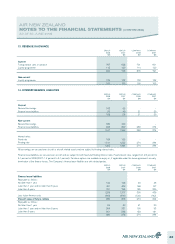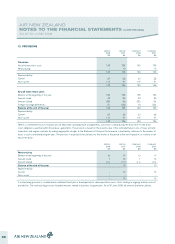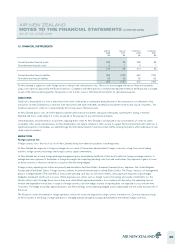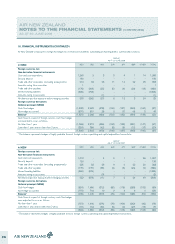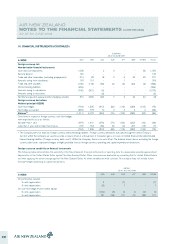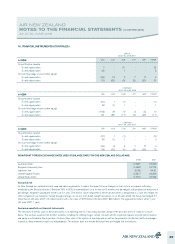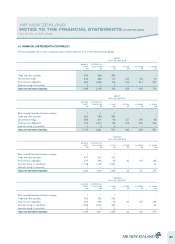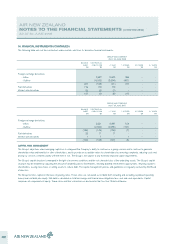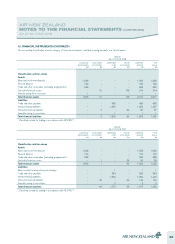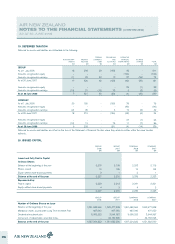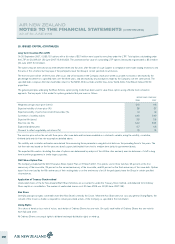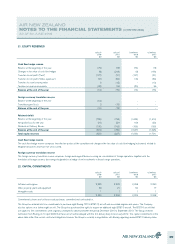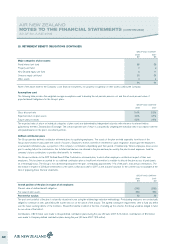Air New Zealand 2008 Annual Report Download - page 34
Download and view the complete annual report
Please find page 34 of the 2008 Air New Zealand annual report below. You can navigate through the pages in the report by either clicking on the pages listed below, or by using the keyword search tool below to find specific information within the annual report.
16. FINANCIAL INSTRUMENTS (CONTINUED)
The following table sets out the contractual, undiscounted cash flows for derivative financial instruments:
GROUP AND COMPANY
AS AT 30 JUNE 2008
BALANCE
SHEET
$M
CONTRACTUAL
CASH FLOWS
$M
< 1 YEAR
$M
1-2 YEARS
$M
2-5 YEARS
$M
5+ YEARS
$M
Foreign exchange derivatives:
- Inflow 3,987 3,603 384 - -
- Outflow (4,095) (3,694) (401) - -
(47) (108) (91) (17) - -
Fuel derivatives 176 173 173 - - -
Interest rate derivatives (2) (2) (2) - - -
127 63 80 (17) - -
GROUP AND COMPANY
AS AT 30 JUNE 2007
BALANCE
SHEET
$M
CONTRACTUAL
CASH FLOWS
$M
< 1 YEAR
$M
1-2 YEARS
$M
2-5 YEARS
$M
5+ YEARS
$M
Foreign exchange derivatives:
- Inflow 2,551 2,397 154 - -
- Outflow (2,696) (2,535) (161) - -
(132) (145) (138) (7) - -
Fuel derivatives 22 11 11 - - -
Interest rate derivatives 1 1 - 1 - -
(109) (133) (127) (6) - -
CAPITAL RISK MANAGEMENT
The Group’s objectives when managing capital are to safeguard the Company’s ability to continue as a going concern and to continue to generate
shareholder value and benefits for other stakeholders, and to provide an acceptable return for shareholders by removing complexity, reducing costs and
pricing our services commensurately with the level of risk. The Group is not subject to any externally imposed capital requirements.
The Group’s capital structure is managed in the light of economic conditions and the risk characteristics of the underlying assets. The Group’s capital
structure may be modified by adjusting the amount of dividends paid to shareholders, initiating dividend reinvestment opportunities, returning capital to
shareholders, issuing new shares or selling assets to reduce debt. The capital management policies and guidelines are regularly reviewed by the Board
of directors.
The Group monitors capital on the basis of gearing ratios. These ratios are calculated as net debt (both including and excluding capitalised operating
leases) over net debt plus equity. Net debt is calculated as total borrowings and finance lease obligations less cash and cash equivalents. Capital
comprises all components of equity. These ratios and their calculation are disclosed in the Five Year Statistical Review.
AIR NEW ZEALAND
NOTES TO THE FINANCIAL STATEMENTS (CONTINUED)
AS AT 30 JUNE 2008
32



